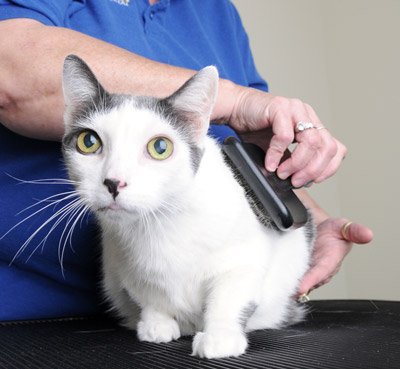Can I stop shedding in my pet?

Every pet sheds. It’s a natural process that helps animals adjust to their environment. But how can you tell if your pet sheds a normal amount or way too much? And is there anything you can do about it? Let’s shed some light on it.
Hair growth cycle basics
The hair growth cycle has four stages (growth, transition, resting, shedding), and individual hairs go through these stages at different times, resulting in a mosaic pattern of growth and shedding. Because dogs have around 15,000 hairs per square inch and cats have between 60,000 and 120,000 hairs per square inch, normal dogs and cats can shed a large amount of hair (and deposit it all over your clothes and furniture) without developing bald patches.
Several factors affect the hair growth cycle. For example, growth is largely affected by the number of hours of daylight as well as temperature. In North America, dogs and cats living outside will typically shed in the spring and fall because of these factors. But when dogs and cats are kept indoors most of the time (meaning their hours of daylight and temperature stay relatively controlled and consistent), families often have to deal with constant shedding. Hormones, health, nutrition and genetic factors can also affect a dog or cat’s hair growth cycle.
What about products promising to stop shedding?
- Brushes and combs. While brushes and combs specifically designed to strip the coat are useful, they only stop shedding by making you comb the hair out before it falls out.
- Nutritional supplements. Nutritional supplements usually contain blends of omega fatty acids, vitamins and minerals. Quality pet foods are well balanced, so adding more supplements doesn’t typically produce an obvious benefit.
- Topicals. Topical products, including shampoos, sprays and conditioners, are effective at moisturizing the skin, making the hair shinier and making brushing easier. However, they don’t actually change shedding. Most of these products are designed to be used along with a de-shedding brush.
More stress = More shedding
 The most common reason for more than normal shedding is stress. For some pets, stress involves riding in the car to visit the veterinarian. For other pets, it might be a strange animal in the yard or a new visitor in the house.
The most common reason for more than normal shedding is stress. For some pets, stress involves riding in the car to visit the veterinarian. For other pets, it might be a strange animal in the yard or a new visitor in the house.
Of course, there are many important medical conditions, such as hypothyroidism and allergies, that can also cause pets to shed more than normal. It’s important to visit your veterinarian when shedding causes patches of missing hair, when the skin appears red or when the shedding is associated with a change in your pet’s behavior or activity.
The bottom line when it comes to normal shedding: Keep calm and brush on (and maybe invest in a good vacuum).
Please contact us if you have any questions.
Source: Darin Dell, DVM, DACVD. DVM360
- Behavior (11)
- Caring for your pet (263)
- cat (4)
- Community Events (19)
- dog (6)
- From Our Clients (15)
- Happy Tails (8)
- News (418)
- Press (53)
- Products (2)
- Questions (4)
- Recalls (1)
- Special Offers (5)
- Tips & Advice (231)
- Uncategorized (19)
- Veterinary Services (48)


